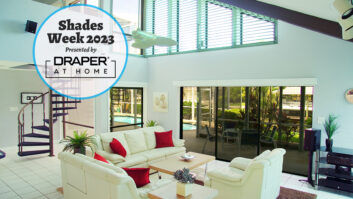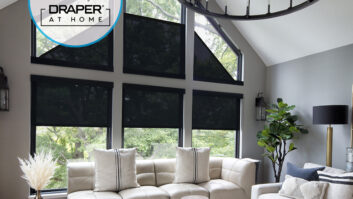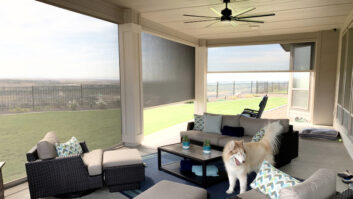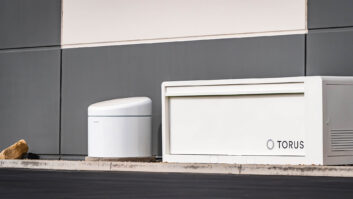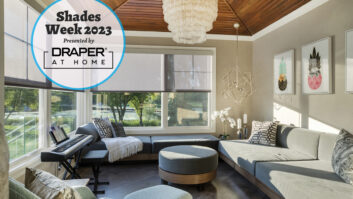Energy and environmental issues have been in the news lately perhaps more than ever. There are new EPA carbon reduction rules, legislative battles looming in many states over hydraulic fracturing (or fracking) for natural gas, Wyoming’s rejection of national science education standards teaching the human role in climate change, and, of course, the old Keystone XL pipeline still stands in limbo. Increasingly, public support of environmental initiatives has been growing, albeit with baby steps in many places, yet recent data suggests we’re reaching a tipping point.

More and more, design professionals are considering some level of simple or startup systems for lighting and shade control, according to Lutron’s David Weinstein.
With dollar signs leading the way, energy efficiency is an angle of this multifaceted subject that garners some of the most support. And the home is the primary testing ground for the technology that enables energy savings.
Automated lighting and shading solutions lead the way when it comes to reducing our carbon footprints at home, and manufacturers affirm that the industry is poised for a perfect storm of consumer adoption and implementation by professionals.
“The awareness and adoption, especially across the ultra high-end markets, is significantly growing in 2014, even over 2013,” said David Weinstein, VP of residential systems sales for Lutron. “I think business conditions and the awareness consumers are getting through advertising, whether it be smartphones or security companies, or so many things on television, are kind of sending the message about control, and lighting, and shading are becoming more of the expectation in the home.”
Weinstein sees this awareness extend to the builders, developers, and interior designer/architect communities, many of whom he spends personal time with. “They see the importance for the categories, and more and more, they’re considering some level of standards for simple or startup systems for lighting and shades,” he said, noting an interesting trend with shading often driving the implementation of these systems more than lighting, due to aesthetic considerations.

The ability to enact vacation scenes automatically or “all off” scenes upon entering an alarm code are all trends Leviton sees homeowners taking advantage of. One force for growth in lighting and shade control systems is the increased implementation of hubs, gateways, and security systems that are beginning to tie into lighting, especially Z-Wave, noted Greg Rhoades, director of marketing for Leviton, “bringing consumer awareness to an all-time high,” he said. “More individuals are exposed to the possibilities of connecting their lights with their security system.”
The extras bells and whistles these systems come with play an important role whetting consumer appetites for the category. The ability to enact vacation scenes automatically or “all off” scenes upon entering an alarm code are all trends Leviton sees homeowners taking advantage of. They value the security, energy, and entertainment benefits that lighting control offers.
“Whether it’s a simple dimmer or a complete ecosystem of smart devices, homeowners want app control from smartphones and tablets,” Rhoades said. “Many of them desire two-way communication, which means that the apps can display the real-time lighting percentage as it is dimmed or brightened, from zero to 100 percent.”
The app factor is undoubtedly a major driver as well. For Hunter Douglas, “It’s all about the app,” according to Paul Kenline, product and brand manager, automated systems. “It has changed the game in regards to consumer perceptions of how they should be connected to their homes. Apps and the mobile devices they work on are the focus; light switches and remote controls are no longer top of mind. Light switches as we know them will not exist in 10 years,” he predicted. “The rate at which technology is being accepted is accelerating faster than it ever has before.”

Lutron has noticed increasing awareness for automated lighting and shades with the builders, developers, and interior designer/architect communities. Mobile apps are steering the evolution of the whole home automation systems toward a connected object world in Somfy’s view. Several companies have developed apps for just simple window covering control. According to Tracy Christmann, director of marketing, Somfy, “These apps are easy to install with on-screen set-up wizards, yet powerful with scheduling capabilities for energy saving benefits and convenient remote access.”
As energy savings continues to be a trend, Christmann has noticed solar-powered solutions in demand, and Somfy offers a fully solar-powered shade for the particularly energy-conscious consumer. Z-Wave- and Zigbee-compatible shades are also growing for Somfy.
Daylight harvesting and controlling solar energy, instead of simply blocking the sun out are important, though awareness in this area could use some work, according to Bob Hadsell, home theater sales manager, Draper. “The value of a custom-made shading system is becoming more tangible to homeowners,” he said. “The payback of artificial lighting and the comfort benefits of well-controlled daylighting is in demand.”
There’s an economic broadening of the market that has developed, in part driven by local dimmer/ keypad use and mobile apps. A more tech savvy, younger consumer entering into construction or renovation projects was identified by Phil Scheetz, shade and lighting marketing manager for Crestron. It’s not just the ultra high-end going to get this type of technology today, “It’s going to be much more mainstream,” he said. “It’s still luxury, but it’s not [just] your two- or three-million dollar house; it might be your four or five or $600,000 house, and even in rental properties, it’s starting to be seen.”
Lights Out for Incandescents
The start of 2014 marked a significant milestone for the lighting industry with the culmination of federally mandated phase-out of most incandescent light bulbs. As part of the Energy Independence and Security Act (EISA) of 2007, this transition has been underway since 2012. While January marked the end for distribution of these bulbs, consumers were faced with a ton of confusion and misleading information about what it all means for them.
The lighting industry continues to work to combat this confusion, and there have been marked changes in the demand for energy efficient lighting solutions, including halogens, compact fluorescent (CFL) bulbs, and the almighty LED. (The metrics of LED lifespan can be a bit fuzzy, but typically they’re advertised as providing light for tens of thousands of hours, and even 100,000, compared with maybe 1,000 hours for an incandescent.)
In the past, LED adoption has been stymied by their substantially higher cost relative to their energy-saving compatriots. Wide reports show the cost is coming down rapidly, and their implementation is increasing. According to Scott Stephenson, Control4’s senior product manager, lighting and comfort, “It’s been building for a while, but we’ve really seen LEDs take off exponentially over the last year.”
Many other lighting manufacturers shared similar comments. “The 2007 law marked a clear turning point in the history of lighting energy management,” said Jim Carroll, Savant’s executive vice president, corporate strategy and business development. “With the phase-out of many incandescent bulbs, we’re seeing a major demand for LED bulbs.”
As a result, LED technology is advancing. “We’re seeing LED bulbs mimic the aesthetic appeal of incandescent light; they can now produce softer light or brighter, more white light, depending on the needs of a particular environment,” Carroll said.
Another effect, Carroll noted, is that consumers are more knowledge about LEDs than they have been in the past. “Today, they are looking at, and asking for, specific types based on details such as maximum wattage, dimming capability, lumens, light color, etc.”
Part of the lack of knowledge about energy efficient light sources concerns the means in which they can be dimmed. Traditional dimmers used for incandescent bulbs do not work well or at all with CFLs and LEDs. As a result of the phase-out, Vantage Controls has increased its dimming requirements and testing “to provide ‘incandescent-like’ dimming a cross wider range of lighting source types,” said Reid Cram, director of marketing.

This infographic from Control4 explains many of the nuances involved with the transition from incandescent light bulbs to more energy efficient sources. Each of the lighting control companies offer their own dimming solutions, many of which are compatible with different types of bulbs, so dealers simply need to be aware of this when spec’ing the systems. Education and training are, therefore, a key part of expanding lighting and shade control systems.
LED Education
Aside from traditional dealer training, Crestron has been performing a lot of LED testing. This involves taking popular fixtures or those that are requested by customers and essentially grading each on what dimmer works best, what the dimming range is, and what the dimming performance. Customers and dealers are invited to send LED fixtures in for testing. If a certain LED fixture flickers at a specific point when a certain number of them are on the circuit, these are the types of details Crestron’s LED report cards share.
“The more thorough the testing that the dimmer manufacturer does, the better performance you’re going to get,” Scheetz said.
Lutron has an LED Control Center of Excellence, a web resource for dealers and consumers to help correctly specify, install, and use LEDs. Testing information and light bulb report cards are available, as well as other educational resources. Additional initiatives from Lutron include CEU training for designers, resource websites for Lutron’s HomeWorks and RadioRA 2, and the Lutron Pleasance app, a mobile dealer tool for specification and installation.
Energy Squad is a national green tech distributor that offers a wide breadth of information through its online Knowledge Center, covering the full spectrum of energy efficient lighting, including educational material about the latest trends and products. The Maryland-based distributor also offers the LED Diet, a program for dealers, trained as LED “dieticians,” to make free and no obligation on-site lighting analyses for homeowners.
Leviton is in the process of opening a new showroom in downtown New Orleans to highlight the latest lighting control and automation options. “We’re moving the former ‘HAI’ Five Star training to this gorgeous new facility to let integrators play with the various solutions, as well as control dozens of shades by Somfy via Leviton apps and touchscreens,” Rhoades said.
Other wireless residential products that are highlighted include Z-Wave and ZigBee devices and Leviton’s commercial GreenMax lighting control system for convention centers and arenas. “We can’t wait to get this fun facility open to our installers and not only teach them, but enable them to interact and fully understand the benefits for various applications.”
For consumers, Leviton offers online lighting guides to help with bulb and dimmer selections, live Q&A webinars about new universal wireless solutions, and technical support.
Control4 travels the country with its Dealer Training Tour to educate dealers about the latest solutions, installation best practices, and marketing strategies. A “Lighting 101” course from the online Control4 University provides dealers with the basics of load types and dimming tech.
Consumer awareness about the technology, its capabilities, benefits, and most importantly, the dramatic changes in the cost in just a few years all stand in the way of widespread deployment of lighting and shading control solutions.
“Consumers must understand the true benefits of intelligent control of lights and shades, and right now, that value is not widely understood,” Savant’s Carroll said. He pointed to the energy savings and enhanced aesthetic value inside and outside a home, as well as scene selection features.
Lighting and shades control are continuously improving and evolving in terms of costs and capabilities, among other factors, Leviton’s Rhoades expressed. He emphasized the continuous aspect in particular, “because there’s enormous movement every day in each of these areas, and I think we all believe it’s simply a matter of when, not if, lighting and shade control will become a standard in residential construction. Frankly, I see it happening rather quickly as there is already tremendous excitement creating precise lighting scenarios and controlling from your phone and tablet.”
Lindsey Adler is associate editor for Residential Systems and Systems Contractor News.

